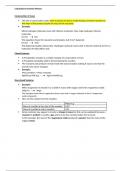Summary
Summary - Unit 1 - Principles and Applications of Science I
- Institution
- PEARSON (PEARSON)
Contains condensed notes of the following topics - Ions, Relative formula mass, Electromagnetic waves, Regulation of communication waves, Conservation of mass. These notes helped me achieve distinction overall.
[Show more]



